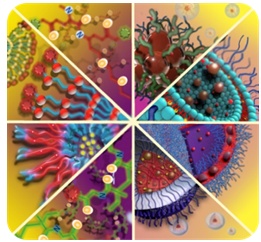Cílený transport léčiv pomocí polymerů a magnetických nanočástic: Kovalentní i nekovalentní přístup, řízení uvolnění léčiv a klinické studie
 Our recent review work published in Chemical Reviews covers the principles, advantages, and drawbacks of passive and active targeting exploiting various polymer and magnetic iron oxide nanoparticle carriers with drug attached by both covalent and noncovalent strategies. Attention is devoted to the tailored conjugation of targeting ligands (e.g., enzymes, antibodies, peptides) to drug carrier systems. Similarly, the approaches toward controlled drug release are discussed in details. Besides polymer−drug conjugates based, the work thoroughly discusses the issue of design and structure of superparamagnetic iron oxide nanoparticles and condensed magnetic clusters with respect to the mechanism of noncovalent drug loading involving hydrophobic and electrostatic interactions, coordination chemistry, and encapsulation in porous materials. Principles of covalent conjugation of drugs with superparamagnetic iron oxide nanoparticles including thermo- and pH-degradable bonds, amide linkage, redox-cleavable bonds, and enzymatically-cleavable bonds are described in details. Finally, results of clinical trials obtained with polymeric and magnetic carriers are analyzed highlighting the potential advantages and future directions in targeted anticancer therapy.
Our recent review work published in Chemical Reviews covers the principles, advantages, and drawbacks of passive and active targeting exploiting various polymer and magnetic iron oxide nanoparticle carriers with drug attached by both covalent and noncovalent strategies. Attention is devoted to the tailored conjugation of targeting ligands (e.g., enzymes, antibodies, peptides) to drug carrier systems. Similarly, the approaches toward controlled drug release are discussed in details. Besides polymer−drug conjugates based, the work thoroughly discusses the issue of design and structure of superparamagnetic iron oxide nanoparticles and condensed magnetic clusters with respect to the mechanism of noncovalent drug loading involving hydrophobic and electrostatic interactions, coordination chemistry, and encapsulation in porous materials. Principles of covalent conjugation of drugs with superparamagnetic iron oxide nanoparticles including thermo- and pH-degradable bonds, amide linkage, redox-cleavable bonds, and enzymatically-cleavable bonds are described in details. Finally, results of clinical trials obtained with polymeric and magnetic carriers are analyzed highlighting the potential advantages and future directions in targeted anticancer therapy.
Ulbrich, K.; Hola, K.; Subr, V.; Bakandritsos, A.; Tucek, J.; Zboril, R. Targeted Drug Delivery with Polymers and Magnetic Nanoparticles: Covalent and Non-Covalent Approaches, Release Control, and Clinical Studies. Chem. Rev. 2016, 116 (9), 5338-5431. DOI: 10.1021/acs.chemrev.5b00589


